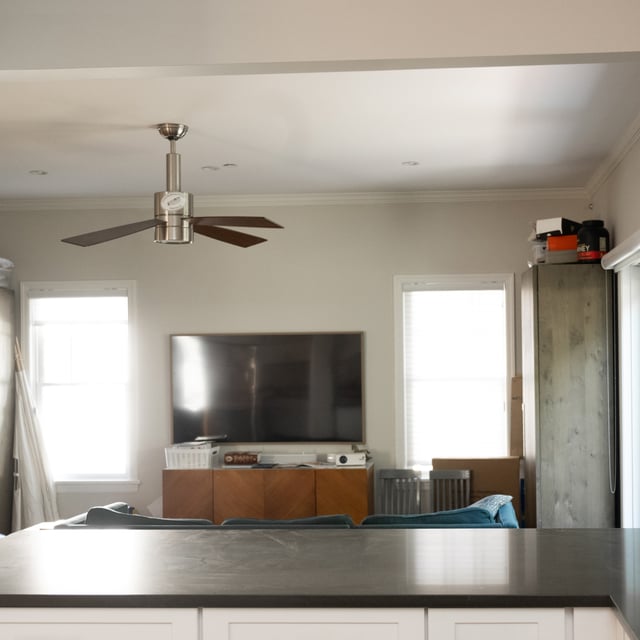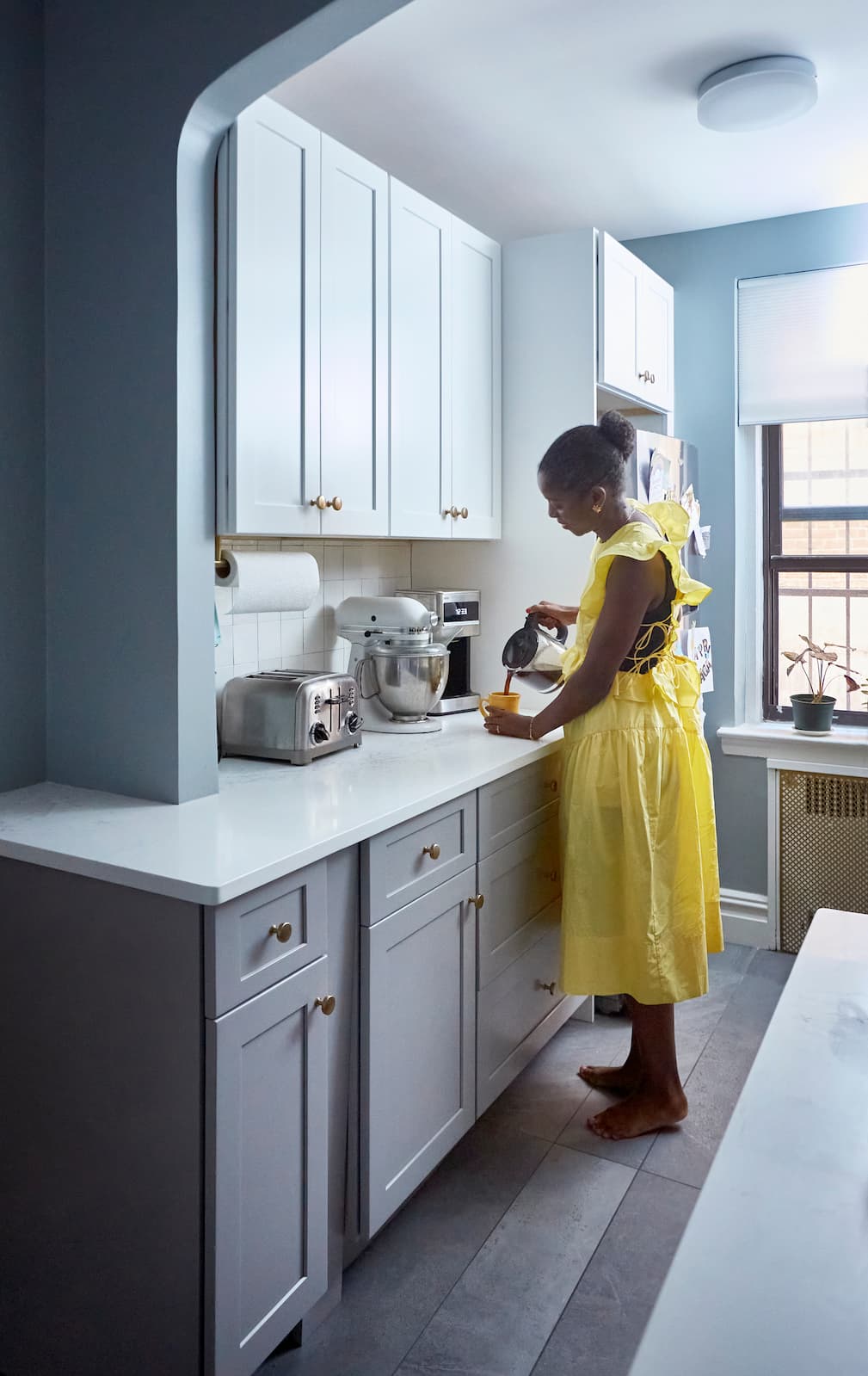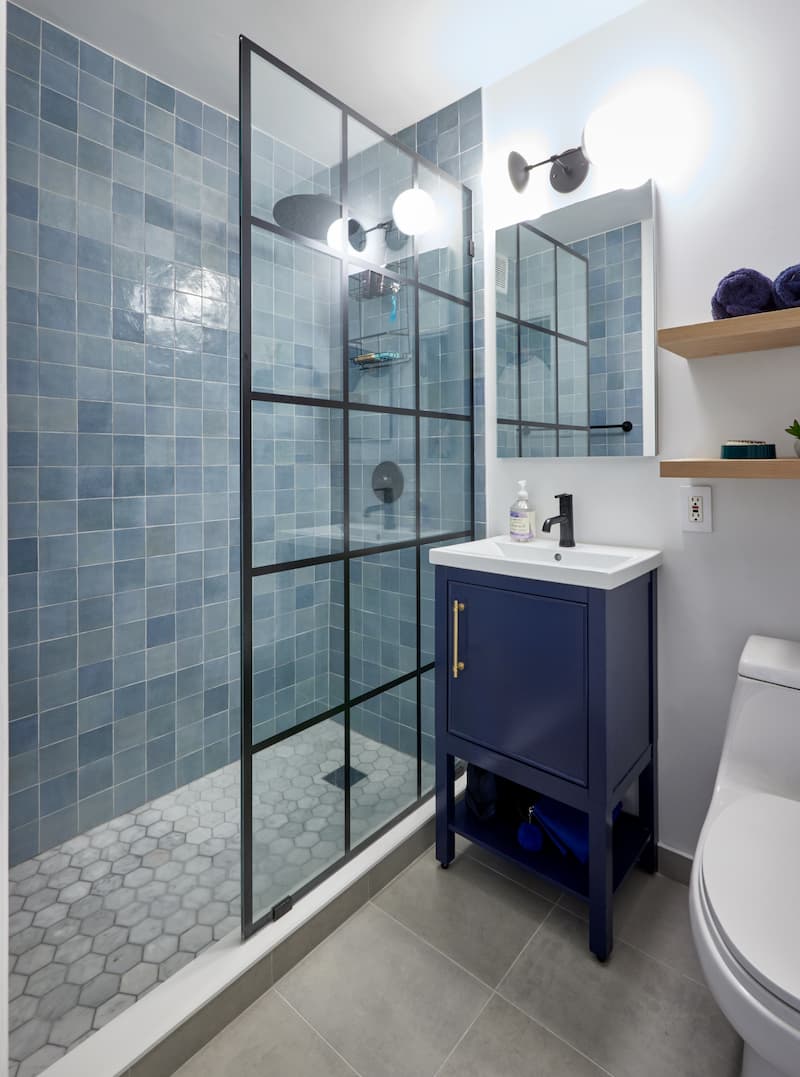
In This Article
Making your home more energy efficient doesn’t have to mean solar panels and a hard hat. Some of the best improvements are the small, sneaky ones—especially when you’re already remodeling. Whether you’re redoing a whole room or just trying to lower that utility bill that keeps giving you a hard time, these energy-efficient updates can make your home comfier, greener, and easier on the wallet.
Assess Your Current Appliances
Before selecting paint colors or backsplash tile, take a close look at your appliances. If the fridge hums louder than your dishwasher sings and the washing machine dances across the floor every spin cycle, it might be time. Old appliances are energy hogs, plain and simple.
A refrigerator that’s over 10 years old can use twice the electricity of a newer ENERGY STAR® model—and probably doesn’t even keep your lettuce crisp. That vintage washer? It uses more water than necessary and takes longer to clean clothes. ENERGY STAR® appliances are designed to do the same job (or better) using less energy and water—no capes required.
And don’t forget the little guys. A clunky microwave or an ancient window air conditioner unit might not seem like a big deal. Still, together, they can quietly increase your energy use even if you’re not ready for all-new everything; small habits—such as running full loads and unplugging devices when not in use—can make a significant difference.
Bonus: Newer appliances are often quieter, smarter, and more aesthetically pleasing. Boosting energy efficiency and getting a glow-up? Yes, please.
Install Overhead Fans
Ceiling fans may not be the most exciting feature in a room, but they quietly contribute to energy savings. In the summer, they keep the air moving so you don’t have to blast the AC—and yes, setting the thermostat a few degrees higher does make a difference. In colder months, just flip the switch to reverse the spin. That sends warm air back down from the ceiling, where it tends to hover uselessly.
It’s one of those energy efficiency upgrades you don’t think twice about... until your room feels better year-round and your energy bill thanks you for it.
Stay on Top of Leaks
Small leaks are sneaky. A slow drip from the faucet or a toilet that never quite shuts up might seem harmless, but over time? They waste gallons of water—and quietly run up your bill. Not to mention, they can drive you a little up the wall at night.
Make it a habit to check under sinks, around toilets, and behind appliances now and then. It takes five minutes, tops. Catching leaks early means less wasted water and a lower chance of discovering something worse later—like a soggy cabinet, a mystery stain, or that dreaded musty smell. It's not the most thrilling task, but it's definitely one of the most underrated.
Invest in Smart Thermostats
If you’re still adjusting your thermostat by hand every day, it may be time for an upgrade. Smart thermostats are one of the easiest ways to cut energy costs without lifting a finger—literally. They learn your routine, adjust the temperature when you're out, and keep things comfy when you're home. So you're not heating an empty house (or freezing your plants).
Most models also give you helpful insights into your energy use, which means you can stop guessing and start saving. And if you're already upgrading your HVAC system, adding a smart thermostat is basically a no-brainer. It’s the cherry on top of a more efficient home.
Have Lights on Sensors
Let’s be real: no one remembers to turn off the hallway light every time. That’s where motion sensors and occupancy sensors come in. They’re like polite little assistants that switch the lights off when you forget—and back on when you walk in with your hands full.
They work especially well in high-traffic zones like closets, bathrooms, and mudrooms. Pair them with LED bulbs, and you’ve got a winning combo for energy savings that you’ll barely notice… except on your utility bill. Less waste, more ease, and zero nagging required.
Arrange Your Home Strategically
The sun might not send you a bill, but it definitely affects the one from your utility company. The way your home is laid out can have a big impact on how much you depend on heating, cooling, and artificial light—so why not make that sunlight work a little harder for you?
Start with your main living areas, including your living room, family room, and dining space. If you're building or remodeling, placing them on the south side of the house is a smart move. That’s where they’ll soak up the most daylight, especially in the winter when warmth and brightness are in short supply. It makes the space feel cozier without touching the thermostat. Bonus: it’s also great for your mood.
Now, bedrooms and kitchens? These do best facing east. They’ll catch that gentle morning sun, which makes early wake-ups feel a little less harsh and gives those first cups of coffee a glow-up. And as the day wears on and things heat up, these rooms naturally cool off—perfect for winding down in the evening.
Utility zones, such as bathrooms, laundry rooms, and garages, don’t require much sunlight, so consider placing them on the north side if possible. This setup helps insulate the rest of the house from hot or cold spots and puts less strain on your heating and cooling systems.
You don’t need to redraw your home's floor plan overnight—but keeping sunlight in mind can make a surprising difference in both comfort and energy efficiency.
Pay Extra Attention to Your Attic
If your attic is just where the holiday decorations go to hibernate, you’re missing a big opportunity. That upper-level space plays a huge role in your home’s overall energy efficiency. Why? Because heat rises. And without proper insulation, it escapes straight through the roof in winter—or turns your house into a sauna come summer.
Upgrading attic insulation is one of the most cost-effective ways to maintain a steady indoor temperature. It gives your heating and cooling systems a break and can lead to noticeable savings on your energy bill. Plus, it’s the first step if you ever want to do future attic remodeling.
Better insulation now = more comfort later (and fewer drafts, too).
Treat Yourself to Heated Floors
Stepping onto a warm floor on a cold morning is one of those tiny luxuries that feels way bigger than it should. But here’s the kicker—heated floors aren’t just about comfort. They’re actually pretty great for energy efficiency, too.
Radiant floor heating warms the room from the ground up. Unlike forced-air systems that lose heat through ducts and warm things unevenly, this setup heats consistently and quietly. Plus, it lets you keep the thermostat lower while still feeling toasty.
You can also zone heated floors to work only in the rooms you use most, so you're not wasting energy warming up the whole house when you're just in the bathroom.
It’s cozy, efficient, and yes—your feet will be living their best life.
To learn more, read our guide to how much heated floors cost.
Evaluate Your HVAC and Heating Systems
Your HVAC system might not be flashy, but it’s doing some serious behind-the-scenes work—and possibly racking up a hefty energy bill while it’s at it. If your setup is over 10 or 15 years old, there's a good chance it’s no longer performing optimally. Modern systems are much more efficient. A newer furnace can convert over 90% of its fuel into heat. Older ones? Closer to 60%. That’s not just a difference in performance—it’s a difference you’ll feel on your utility bill.
Cooling systems have also stepped up their game. Today’s air conditioners and heat pumps use far less electricity to keep your home feeling chill. But if replacing the whole system isn’t on the table right now, don’t sweat it—regular maintenance can still make a big impact.
Change your air filter every couple of months (yes, really), and have a professional inspect your system once a year. Problems like dirty coils or low refrigerant might seem small, but they can throw your system way off balance.
One more low-effort, high-reward move? Seal and insulate your ductwork. You could be losing up to 30% of your heated or cooled air before it even hits the room. That’s basically paying to condition your attic. A little sealing tape and insulation can go a long way toward keeping your home cozy and energy efficient.
Upgrade Your Windows and Doors
Windows and doors might seem innocent enough—but when it comes to energy loss, they’re often the main culprits. The good news? A few upgrades and a little maintenance can turn them from energy drains into efficiency heroes.
Windows
Still holding onto those old single-pane windows? It might be time to upgrade. Switching to double- or triple-pane models can make a big difference in keeping your home comfortable and your energy bills in check. Look for ones with insulating gas fill and Low-E coatings. These high-efficiency windows act like sunglasses in the summer and thermal blankets in winter, helping to regulate your indoor temperature year-round.
But don’t worry—if full replacement isn’t in the cards right now, there are still plenty of easy wins. Caulk the gaps, swap out worn weather stripping, and consider storm windows or insulating window film for a quick, cost-effective boost. These small fixes might not seem flashy, but they can definitely reduce drafts and energy loss.
Quick reminder: give your windows a check each season. A little cracked caulk or a tired seal might not look like much, but it can quietly undo all your hard work on energy efficiency.
Doors
Doors may seem solid, but they can be sneaky sources of energy loss—especially if you’re spotting daylight around the edges. If you’re in the market for a new one, opt for an insulated model with a solid core or thermal break. It’s built to keep the outdoor air out and the cozy air in, no matter the season.
Still, sticking with your current door? All good—just check for drafts along the edges and bottom. Installing fresh weather stripping and adding a simple door sweep can stop cold air in its tracks. It’s one of those easy fixes that makes a big difference right away.
Just like with windows, routine check-ins are key. Look for sagging hinges, worn-out seals, or frames that don’t quite sit right anymore. Catch it early, and you’ll avoid bigger (and colder) problems down the line.
Evaluate Your Air Ducts for Leaks
If your home’s heating and cooling system feels like it’s working overtime—but the results aren’t adding up—leaky ductwork could be the culprit. Up to 30% of the air moving through your HVAC system can be lost through small cracks, gaps, or loose connections. That’s a whole lot of treated air (and money) disappearing into your attic or walls.
A professional inspection can quickly pinpoint trouble spots. Once found, sealing and insulating your ducts helps your system run more efficiently and keeps the temperature more consistent from room to room. It’s not the flashiest home improvement, but it’s a seriously smart one.
Equip Your Windows with Insulating Shades
Here’s something not everyone realizes: your windows? They’re kind of freeloaders when it comes to heating and cooling. The good news is that insulating shades and thermal curtains can actually help pull their weight. They act like a buffer between your home and whatever’s happening outside—keeping the heat in during the winter and blocking it out when summer turns things up to eleven.
And no, you don’t have to sacrifice style. These aren't just bland, utility-first window treatments. Whether you're into clean and minimal or a cozier, layered look, there are options that look great and help cut down on your energy bill. Think of it as dressing your windows for the weather—with taste.
Be Strategic With Your Choice of Insulation
Insulation isn’t exactly the part of your home you show off to guests—but it’s doing some serious heavy lifting behind the scenes. Without the right kind (or the right amount), you’re basically paying to heat and cool your walls. Not ideal for energy efficiency.
If you’re already cracking open the attic or pulling down drywall during a remodel, it’s the perfect time to upgrade. Different spots in the house need different approaches—spray foam for tight corners, blown-in cellulose for those wide attic spaces, or foam boards if you need something extra solid. Your contractor can walk you through what makes the most sense.
Bottom line: Good insulation keeps your home comfortable without putting a strain on your HVAC system. Or worse, break down.
Look Into Replacing an Aging Roof
Let’s talk about your roof. It might not be leaking (yet), but if it’s old enough to remember flip phones, it’s probably not doing your energy efficiency any favors. Roofs play a big role in how your home handles heat—and replacing an aging one with a more efficient option can make a real difference.
One upgrade to consider? A cool roof. Despite the name, it’s not a trend—it’s a roofing material that reflects sunlight rather than absorbing it. That means your house stays cooler when it’s blazing outside, and your air conditioner gets a bit of a break.
Is it a big investment? Yeah. But it’s also one that pays off over time—in lower bills, better comfort, and fewer surprise buckets on the floor.
Design With Energy-Efficient Materials
The materials you choose for your home don’t just affect its appearance—they impact its performance. Some materials pull double duty: they look great and help keep your energy bills in check. Take cork, for example. It’s not just for wine bottles or trendy coasters—it’s a renewable resource that naturally insulates, helping to keep indoor temps steady. Floors and wall panels made with cork can actually reduce how often your heater or AC kicks on.
Then, there are insulated concrete forms (ICFs), which sound more complicated than they are. They’re concrete walls with built-in insulation—strong, durable, and surprisingly energy-smart. Homes built with ICFs are easier to heat and cool, which is good news for your comfort and your carbon footprint.
The big idea? Pick materials that work for you not just look good on a Pinterest board.
What Homeowners Should Know About Federal Tax Credits Tied to Energy Efficiency
Here’s some welcome news from the IRS: Through 2032, homeowners can claim federal tax credits of up to $3,200 per year for qualifying energy efficient home improvements. That’s up to 30% back on upgrades like insulation, new windows, doors, heat pumps—you name it. If it makes your home greener, it might also help you save some money.
Separate credits are available for clean energy equipment, such as solar panels, geothermal systems, and battery storage, also at a 30% rate through 2032. Just keep in mind: the credit for most improvements is nonrefundable, meaning you can’t get back more than you owe in taxes. (Clean energy credits can be carried forward, though, which is a nice bonus.)
Starting in 2025, some products will require manufacturer codes on your tax forms. You’ll also need to keep receipts and documentation and file IRS Form 5695 when you do your taxes. So yes, a little paperwork—but it could mean real savings, year after year, for a full decade.
How Energy-Efficient Home Improvements Can Boost Resale Value
Want a home improvement that pays you back and makes buyers perk up? Energy efficiency is it. Upgrades like new windows, smart HVAC systems, or solid insulation are no longer considered extras—they’re what a lot of buyers expect.
As energy costs climb, homes that offer built-in savings tend to stand out. Buyers love comfort and lower monthly bills, which can make your home more appealing—and even push the price higher when it’s time to sell.
To get the most out of your upgrades, don’t just do them—document them. Mention features like ENERGY STAR® appliances or smart thermostats in your listing. Show utility bills with lower usage or obtain a home energy audit to support your claims. Certifications like ENERGY STAR® or a Home Energy Score can add even more credibility—and confidence for buyers.
Make Your Home More Energy Efficient With Block Renovation
Here’s the thing: energy-efficient upgrades can be a little overwhelming, especially when you’re juggling design choices, budget decisions, and trying to figure out if that new heat pump qualifies for a tax credit.
That’s where Block Renovation comes in. We connect you with expert contractors who know the ins and outs of energy-efficient remodeling—and our digital planner helps you map out your renovation, estimate costs, and understand how every choice impacts comfort and efficiency.
You’ll get clear pricing, expert-reviewed scopes of work, and support from start to finish. Whether you’re upgrading windows, adding insulation, or navigating rebates and credits, we help take the guesswork out of going green. With Block, you’re not just making improvements—you’re making smart, lasting ones that feel good now and pay off in the long run.

Written by Block Renovation

Renovate confidently with Block
Easily compare quotes from top quality contractors, and get peace of mind with warranty & price protections.
Thousands of homeowners have renovated with Block

4.5 Stars (100+)

4.7 Stars (100+)

4.5 Stars (75+)
Renovate confidently
- Top quality contractors
- Warranty & price protections
- Expert resources

